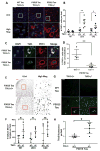Reducing the RNA binding protein TIA1 protects against tau-mediated neurodegeneration in vivo
- PMID: 29273772
- PMCID: PMC5745051
- DOI: 10.1038/s41593-017-0022-z
Reducing the RNA binding protein TIA1 protects against tau-mediated neurodegeneration in vivo
Abstract
Emerging studies suggest a role for tau in regulating the biology of RNA binding proteins (RBPs). We now show that reducing the RBP T-cell intracellular antigen 1 (TIA1) in vivo protects against neurodegeneration and prolongs survival in transgenic P301S Tau mice. Biochemical fractionation shows co-enrichment and co-localization of tau oligomers and RBPs in transgenic P301S Tau mice. Reducing TIA1 decreased the number and size of granules co-localizing with stress granule markers. Decreasing TIA1 also inhibited the accumulation of tau oligomers at the expense of increasing neurofibrillary tangles. Despite the increase in neurofibrillary tangles, TIA1 reduction increased neuronal survival and rescued behavioral deficits and lifespan. These data provide in vivo evidence that TIA1 plays a key role in mediating toxicity and further suggest that RBPs direct the pathway of tau aggregation and the resulting neurodegeneration. We propose a model in which dysfunction of the translational stress response leads to tau-mediated pathology.
Conflict of interest statement
Figures







Comment in
-
Neurodegenerative disease: Tackling tauopathy.Nat Rev Neurosci. 2017 Dec 14;19(1):1. doi: 10.1038/nrn.2017.163. Nat Rev Neurosci. 2017. PMID: 29238082 No abstract available.
References
-
- Anderson P, Kedersha N. Stress granules: the Tao of RNA triage. Trends Biochem Sci. 2008;33:141–150. - PubMed
Publication types
MeSH terms
Substances
Grants and funding
LinkOut - more resources
Full Text Sources
Other Literature Sources
Molecular Biology Databases
Miscellaneous

